This article highlights nine essential ABA intervention strategies that parents can use to effectively support their children’s behavioral development. By focusing on personalized approaches like positive reinforcement, discrete trial training, and natural environment teaching, it shows how tailored strategies can lead to meaningful improvements in communication and adaptive skills for children with autism. Let’s explore this together and see how these strategies can make a difference!
Navigating the world of Autism Spectrum Disorder (ASD) can feel overwhelming for parents, can't it? Understanding the complexities of behavior is no small feat. But don’t worry—the right Applied Behavior Analysis (ABA) intervention strategies can truly make a difference. They offer not just hope, but real pathways to improved communication and behavior.
In this article, we’ll explore nine essential ABA strategies that empower parents:
What challenges do you face in implementing these strategies? How can you effectively support your child's unique journey toward independence and growth? Let’s dive in together!
At Rori Care, we believe in a customized approach to ABA intervention strategies that genuinely addresses the unique needs of each young person. This means every ABA intervention strategies plan is thoughtfully tailored to address specific behavioral challenges while also celebrating the student’s strengths and interests. By doing this, we create a learning environment that’s not just effective but also engaging!
When we focus on personalized support, it helps parents and clinicians connect with the young individual in meaningful ways. This connection can lead to significant changes in behavior and impressive developmental outcomes. Our dedicated behavior analysts craft personalized behavior plans filled with measurable objectives and ABA intervention strategies backed by research, always assessing and fine-tuning the interventions to boost results.
Research shows that those who receive tailored ABA therapy experience remarkable improvements in communication and adaptive functioning. In fact, studies reveal an impressive success rate of over 89% in enhancing various aspects of development! Take Ethan, for example—his journey highlights how ABA intervention strategies can lead to incredible progress, including a 70% reduction in tantrums and newfound functional communication skills.
This commitment to personalized care is vital for making ABA therapy effective, paving the way for a brighter future for youth with autism. Remember, timely intervention is key for individuals with Autism Spectrum Disorder (ASD), typically starting before age five. ABA intervention strategies play a crucial role in this early support.
Let’s explore this together! We’re here to help you every step of the way as you navigate this journey.
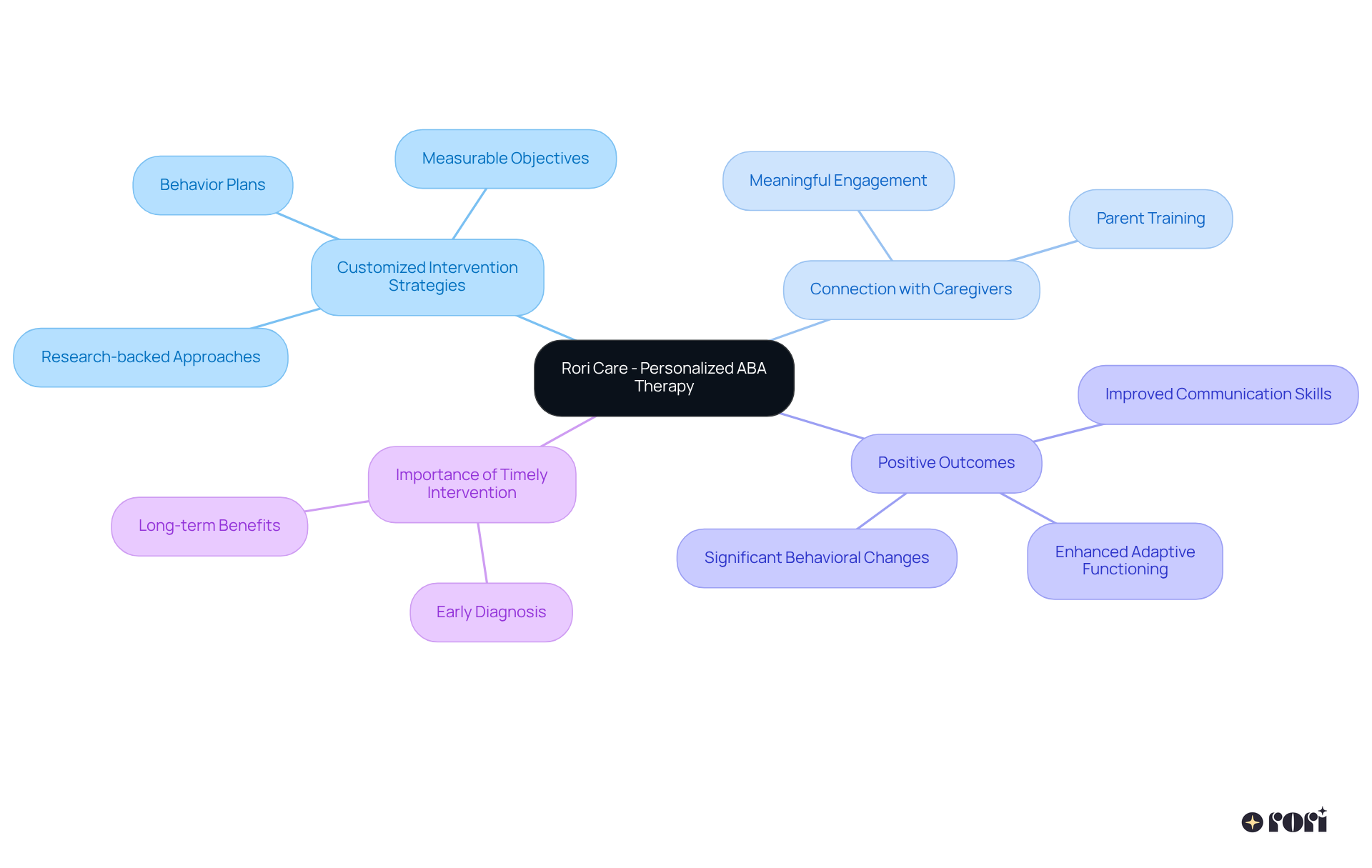
Positive reinforcement is such a powerful strategy! It involves offering a reward after a desired action, which helps encourage that action to be repeated. Parents can use various incentives, like verbal praise, tokens, or special privileges, to motivate their kids to engage in positive behaviors. It's important to recognize what specifically drives each child; it could range from a favorite activity to a small treat. Remember, the reinforcement should be immediate and consistent to really strengthen that connection between the behavior and the reward.
In the world of Applied Behavior Analysis (ABA), ABA intervention strategies that utilize positive reinforcement play a vital role in creating personalized plans. Each behavioral plan is tailored to meet the unique needs of the individual by utilizing ABA intervention strategies, ensuring that the rewards used are both effective and meaningful. Research shows that when teachers use positive reinforcement techniques, students can focus on tasks up to 30% more effectively! This principle can also be applied at home. Promptly acknowledging positive actions can significantly boost a child's motivation and engagement. For instance, complimenting a child for completing a task or sharing toys can reinforce those behaviors, making them more likely to happen again.
Here are some effective rewards you might consider:
By understanding and implementing these helpful reinforcement methods, parents can create a nurturing environment that fosters desirable behaviors, ultimately helping their children thrive. Plus, it's crucial to continually assess these ABA intervention strategies; parents should regularly check in on their child's progress and adjust rewards as needed to ensure their lasting effectiveness. This approach not only enhances behavioral outcomes but also empowers caregivers with the knowledge and skills to support their child's development effectively. Let’s explore this together!
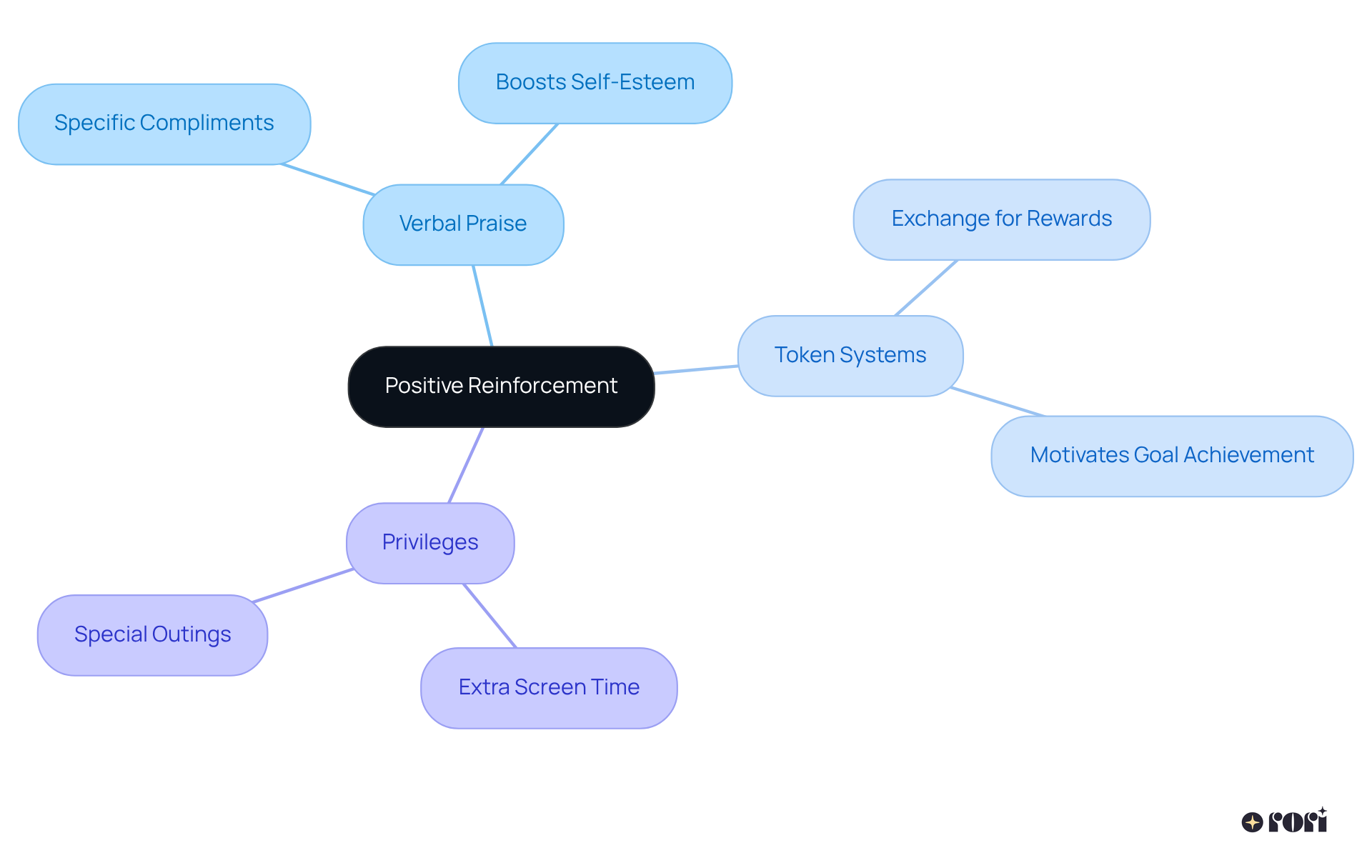
Discrete Trial Training (DTT) is a wonderful method that breaks down abilities into smaller, manageable pieces, making learning more organized and accessible. Each trial includes a clear instruction, the participant's response, and prompt feedback, which helps with repeated practice and reinforcement. This approach has shown impressive results in improving learning for young individuals with autism. Research even suggests that starting DTT early often leads to the best outcomes!
To make DTT work well at home, parents should aim for specific, measurable goals using the SMART framework. Clear prompts and consistent feedback are key to helping young learners master new skills. For example, creating a structured learning environment that minimizes distractions can help your child focus on the task at hand. Plus, staying in touch with ABA therapists can really boost the effectiveness of DTT, allowing for adjustments based on what you see at home.
There are so many success stories out there! One case study highlighted a young individual who, through consistent DTT practice, improved their communication and social skills, leading to greater independence. By weaving evidence-supported methods and DTT into daily activities, parents can encourage behavior generalization, which means their children can use learned behaviors in different settings—this is so important for lasting success.
As Rori Care - ABA Therapy says, "By focusing on individualized learning goals and maintaining consistency in instruction and reinforcement, DTT can be a highly effective approach for teaching individuals with autism." Additionally, when caregivers are equipped with ABA intervention strategies, they can better support their child's behavioral goals through active participation and data collection. In summary, DTT is a powerful tool for skill acquisition that parents can easily implement at home. By focusing on organized learning, setting clear objectives, and ensuring consistent reinforcement, families can effectively support their child's development. Remember to regularly communicate with your child's ABA therapist to adjust strategies based on what you observe together. Let’s explore this journey together!
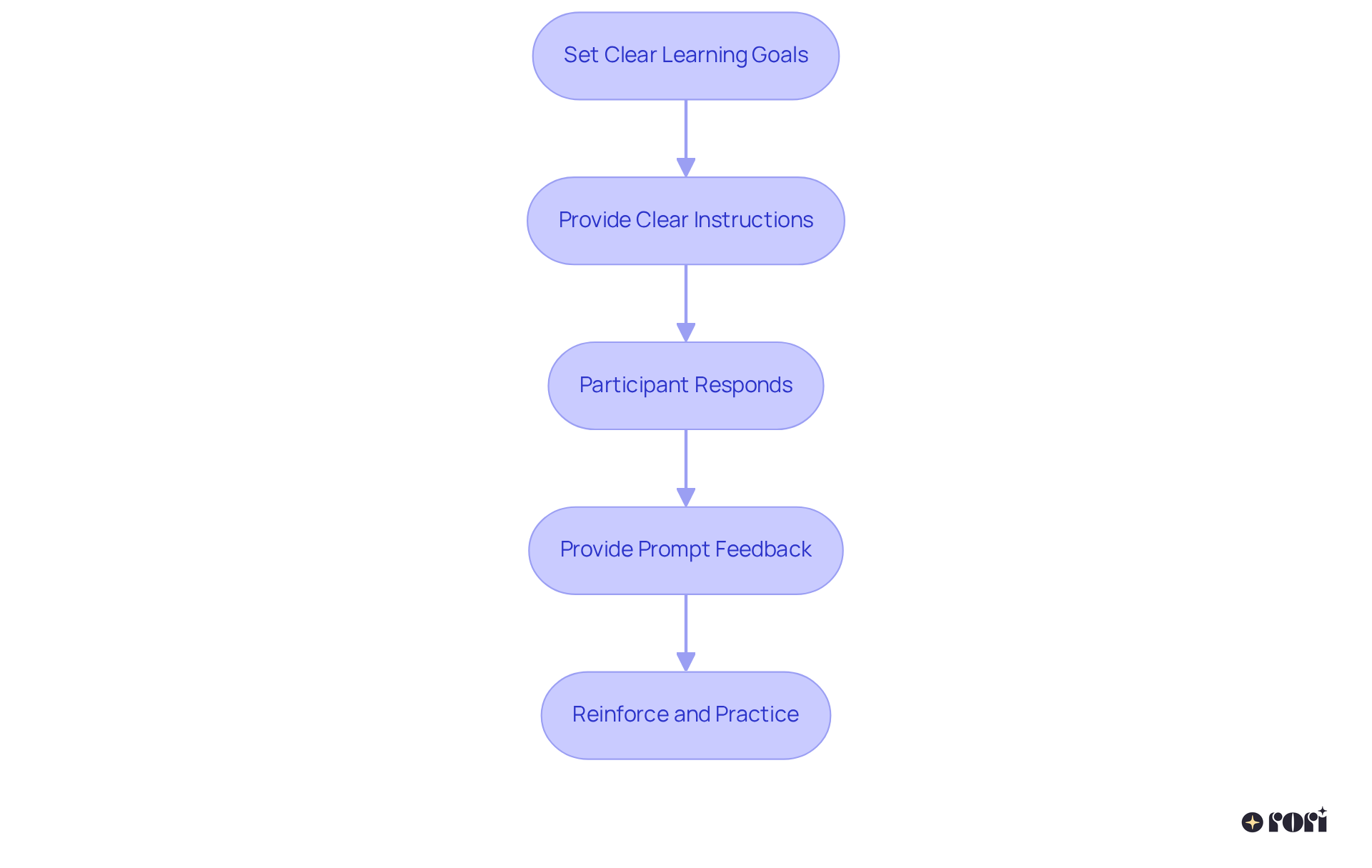
Natural Environment Teaching (NET) emphasizes the importance of developing skills through everyday activities, helping young people learn in familiar settings. This approach encourages parents to spot and seize teachable moments during daily routines—like grocery shopping, playtime, or family outings—to reinforce essential skills. By weaving learning into natural interactions, children are more likely to apply their skills in various situations, boosting their independence and confidence. This method is especially beneficial for young individuals facing behavioral challenges such as Autism Spectrum Disorders, ADHD, and learning disabilities.
For instance, while grocery shopping, parents can encourage their kids to:
These real-life situations not only make learning relevant but also promote spontaneous communication and social interactions. As children practice skills in these authentic environments, they gain a deeper understanding of their purpose and context, leading to more practical skill acquisition.
Parents who have embraced NET often share their stories, highlighting how this approach has transformed their interactions with their children. One parent shared, "Using everyday moments to teach my child has made learning feel natural and enjoyable." It’s truly rewarding to witness them apply what they’ve learned in various situations.
The impact of contextual learning is profound; it allows young people to practice skills in settings where they will ultimately use them, improving retention and application. By focusing on real-life contexts for skill development, parents can significantly boost their children's ability to navigate the world with confidence and competence. Plus, equipping caregivers with ABA intervention strategies through education enhances their ability to support their children's behavioral goals, resulting in better outcomes and a more harmonious family dynamic. Let’s explore this together!
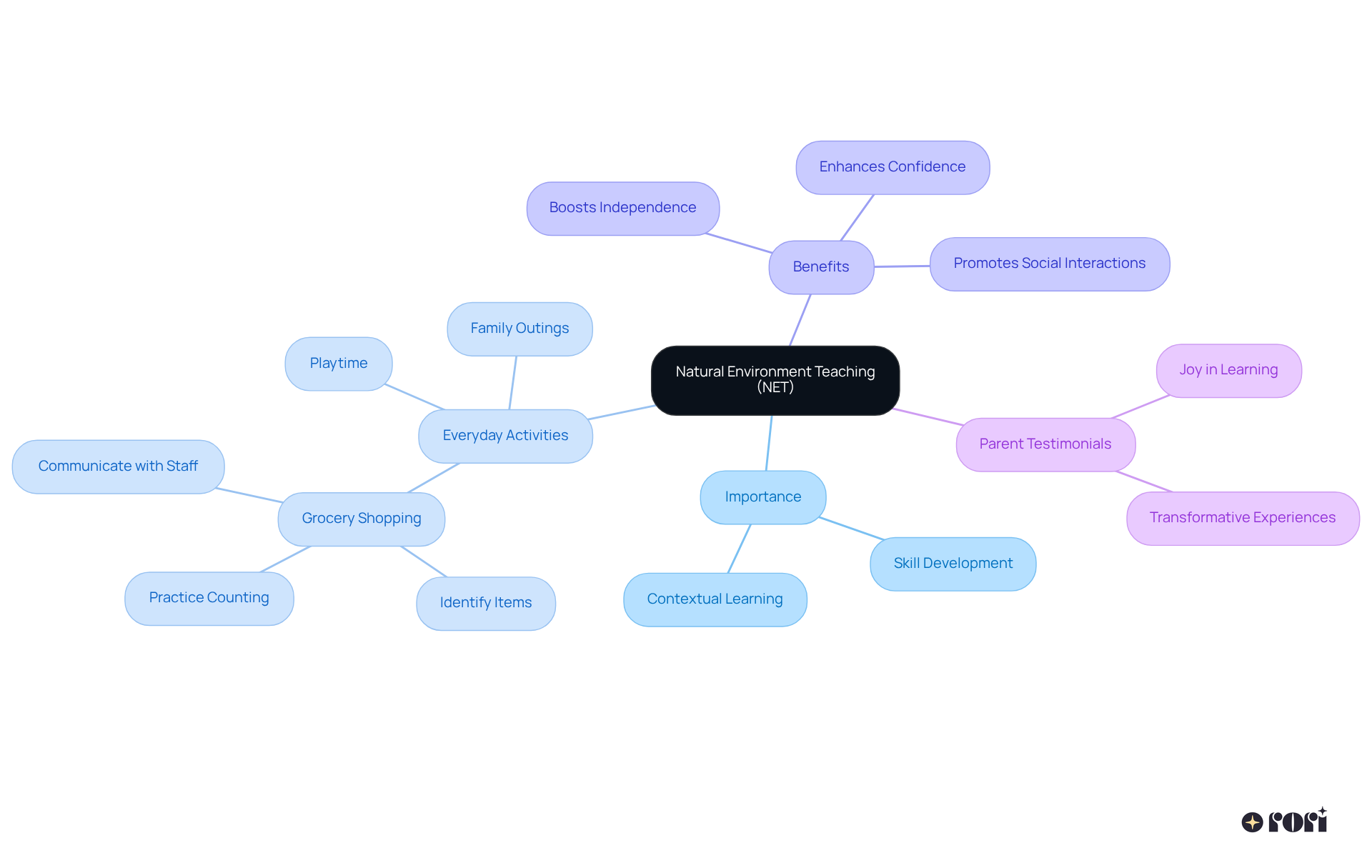
Functional Communication Training (FCT) is such a vital method that helps young individuals express their needs and wants effectively. This approach not only minimizes frustration but also reduces challenging behaviors. So, how can parents implement FCT? It starts with identifying the underlying functions of their child’s challenging conduct. This means understanding what the little one is trying to communicate through their actions. Once these functions are recognized, parents can teach alternative communication methods, like using verbal expressions, gestures, or even picture exchange systems.
Research shows that enhancing communication skills can lead to significant behavioral improvements. For instance, children who learn to communicate effectively are less likely to throw tantrums or engage in other disruptive actions. There are wonderful success stories of FCT implementation, demonstrating how kids can make remarkable progress in their communication skills, which ultimately leads to a more harmonious home environment.
Integrating social skills group therapy, guided by qualified therapists, can further enhance these communication efforts. Group settings encourage better social interactions and relationships, giving youngsters the chance to practice their skills in a supportive environment. It’s also crucial for caregivers to be actively involved. Research indicates that when suggested hours are fully executed with caregiver engagement, about 90% of children show significant progress. This synergy between therapy and home support empowers caregivers with ABA intervention strategies, allowing them to make informed decisions that positively impact their child’s development.
The care engine plays a key role in this journey by updating treatment plans based on progress reports, ensuring that interventions stay adaptive and effective. Speech therapists often highlight the transformative power of effective communication strategies. They point out that promoting communication abilities not only helps in reducing challenging behaviors but also enhances overall social interactions and emotional well-being. By prioritizing FCT and engaging in caregiver education, parents can create a nurturing framework that fosters their child’s growth and independence. Let’s explore this together!
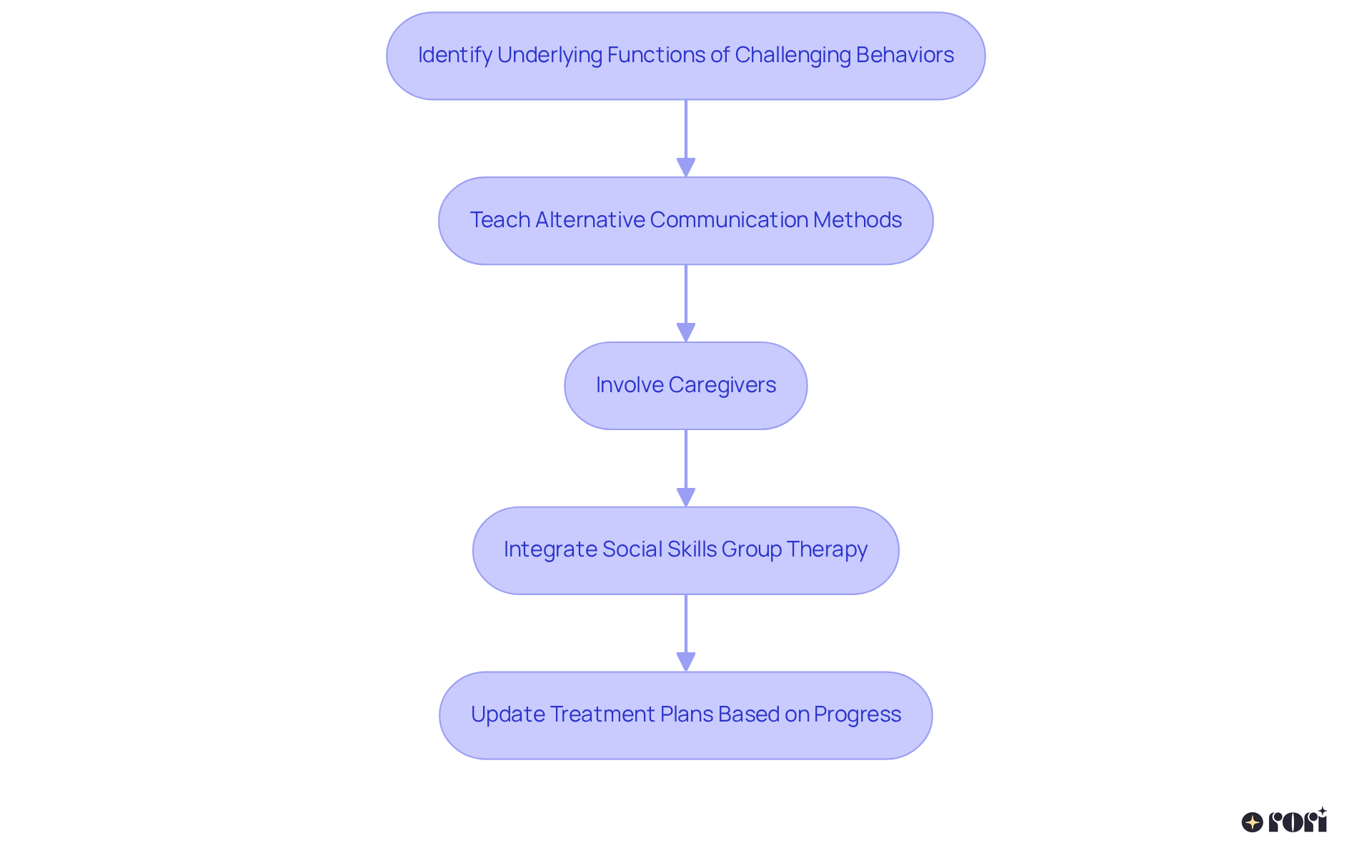
Task analysis, as part of ABA intervention strategies in ABA therapy, is a fantastic method that breaks down complex skills into smaller, sequential steps, making learning easier for kids. Parents can easily implement this strategy by first identifying the specific steps involved in everyday tasks, like brushing teeth or getting dressed. Each step should be taught separately, allowing students to focus on mastering one element at a time. For example, when teaching handwashing, parents can break it down into manageable actions:
Reinforcement plays a vital role in this process. By providing positive feedback for every successful effort, young learners feel motivated to keep practicing, which nurtures a sense of achievement and boosts their confidence. Research shows that ABA intervention strategies, particularly task analysis, not only enhance learning but also promote independence, as children learn to carry out tasks without constant support.
Behavior analysts emphasize the importance of customizing task analysis using ABA intervention strategies to cater to each individual's unique learning style and needs. For instance, Becky Dees, an Educational Consultant specializing in Autism Spectrum Disorder, highlights that effective ABA intervention strategies, such as task analysis, can significantly enhance daily living skills by breaking tasks into manageable parts. This organized approach not only reduces frustration but also empowers young learners to take charge of their education.
Recent studies back up the effectiveness of task analysis in various settings, indicating that when tasks are divided into no more than seven steps, individuals with autism can achieve better performance results. This method has been successfully applied in everyday practices, helping young people manage complex tasks with greater ease and confidence. By embracing task analysis, parents can foster a supportive learning environment that encourages their children to thrive. Let’s explore this together!
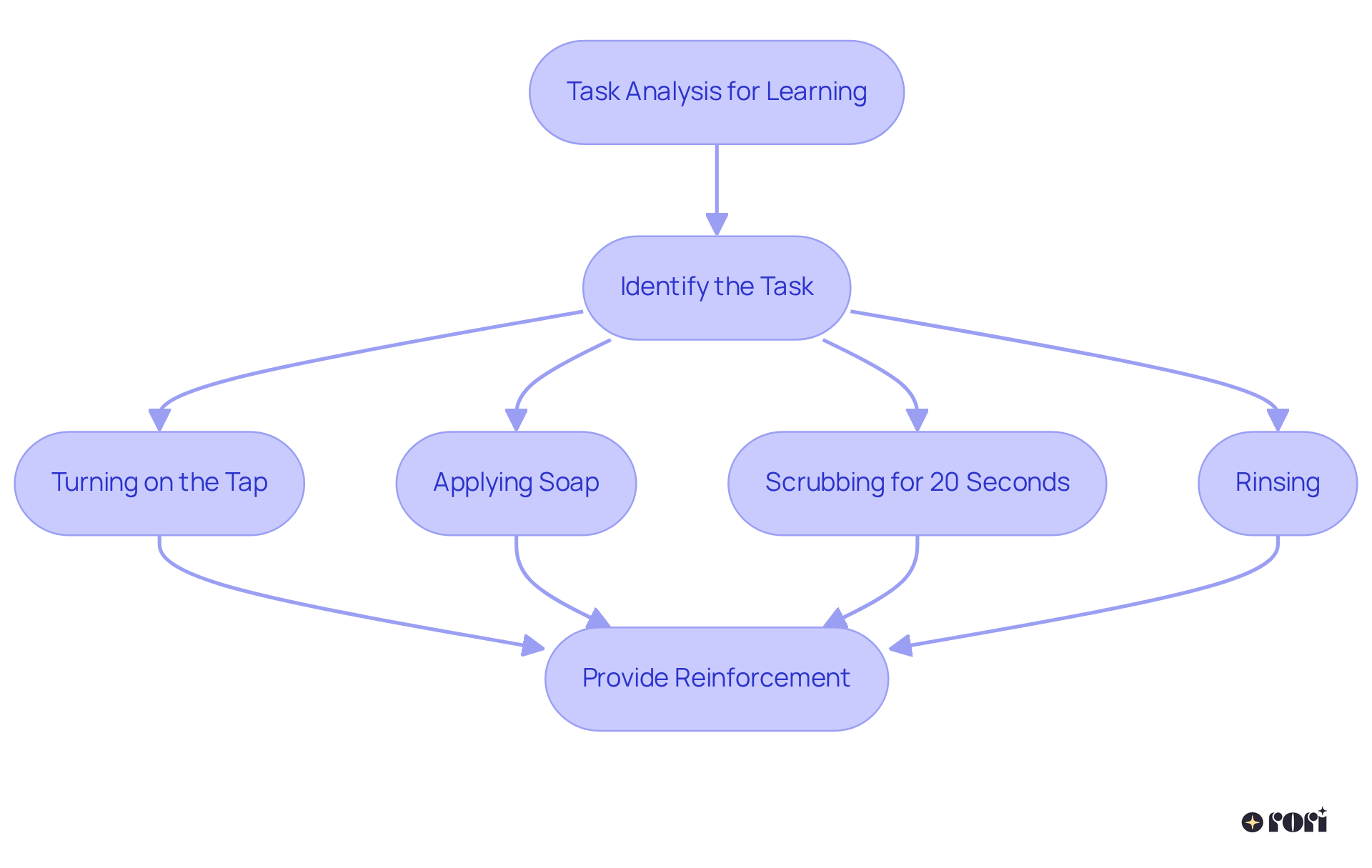
Visual supports like charts, pictures, and schedules are truly essential for helping young people grasp and remember information in ABA therapy. By creating visual aids that outline daily routines, illustrate task completion steps, or show social scenarios, parents can really boost their child's understanding of concepts and expectations. These tools not only improve communication and behavior but also create a sense of organization and predictability—something that can be particularly comforting for kids on the autism spectrum.
Research shows that visual aids can lead to smoother transitions and greater independence. They provide clear signals that help reduce anxiety and enhance comprehension. For instance, visual schedules can help kids get a handle on the rhythm of their day, while social stories offer tailored narratives that prepare them for changes, building resilience and confidence. As educators often point out, visual aids empower kids to actively participate in their daily lives, bridging communication gaps and improving their ability to navigate their surroundings.
When caregivers are trained in ABA intervention strategies and techniques, they can align these visual supports with therapeutic goals, leading to better behavioral outcomes and a more effective approach. By weaving these strategies into everyday routines, families can create a supportive environment that nurtures emotional health and development for their little ones. Let’s explore this together and see how these tools can make a difference in your child’s life!
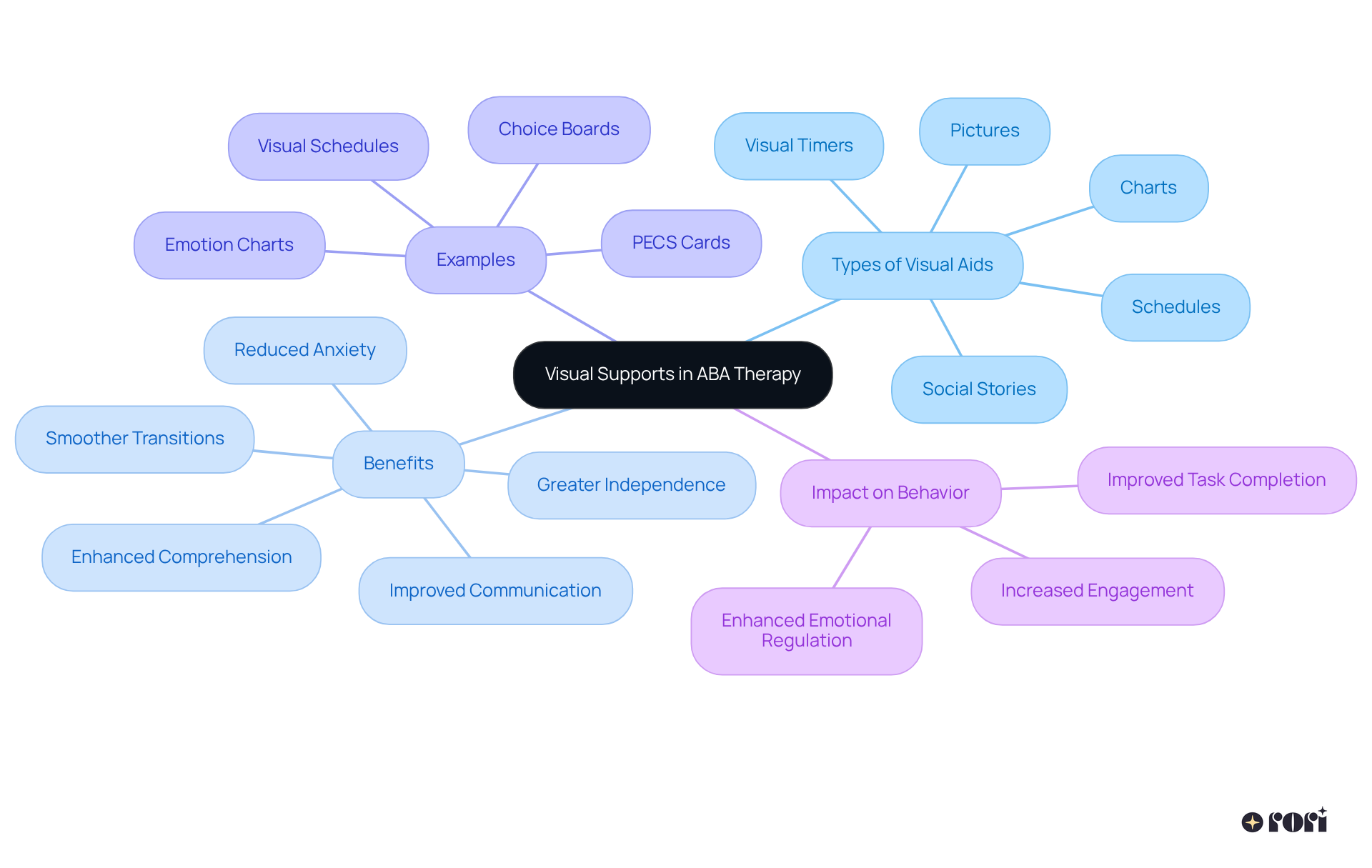
Prompting is such an important tactic within ABA intervention strategies! It involves using cues to help individuals show desired behaviors. These cues can be verbal, visual, or physical, and they’re tailored to fit the individual’s needs. As young individuals get better at a skill, it’s key to gradually reduce these cues. This not only promotes their independence but also boosts their confidence, allowing them to apply what they’ve learned in different situations.
Current best practices remind us how vital a structured fading plan is. It starts with more intrusive prompts and gradually moves to less intrusive ones. Research shows that Most-to-Least (MTL) prompting is particularly effective. Why? Because it allows for immediate reinforcement and quicker skill acquisition compared to Least-to-Most (LTM) prompting. In fact, studies have indicated that youngsters who received MTL prompting reached mastery in fewer sessions. Isn’t that impressive?
There are so many successful examples of encouraging independence through gradual fading! Imagine young individuals moving from full physical assistance to just verbal prompts, and then ultimately performing tasks on their own. Clinicians really stress the importance of tracking progress closely. This way, they can address any setbacks and ensure that young individuals continue to flourish. As one expert wisely noted, “Utilizing differential reinforcement and saving the most powerful reinforcers for independent responses is crucial for fostering autonomy.”
To effectively encourage independence while teaching new skills, parents should remain flexible in their approach. Adjusting prompts based on how their child responds is key. This adaptability, along with consistent monitoring and data collection, makes sure that young individuals receive the right support as they learn and grow. By embracing ABA intervention strategies, caregivers can significantly enhance their ability to support their children’s behavioral goals. This leads to informed decision-making and improved outcomes. Ultimately, this empowers caregivers, paving the way for lasting success in their daily lives. Let’s explore this together!
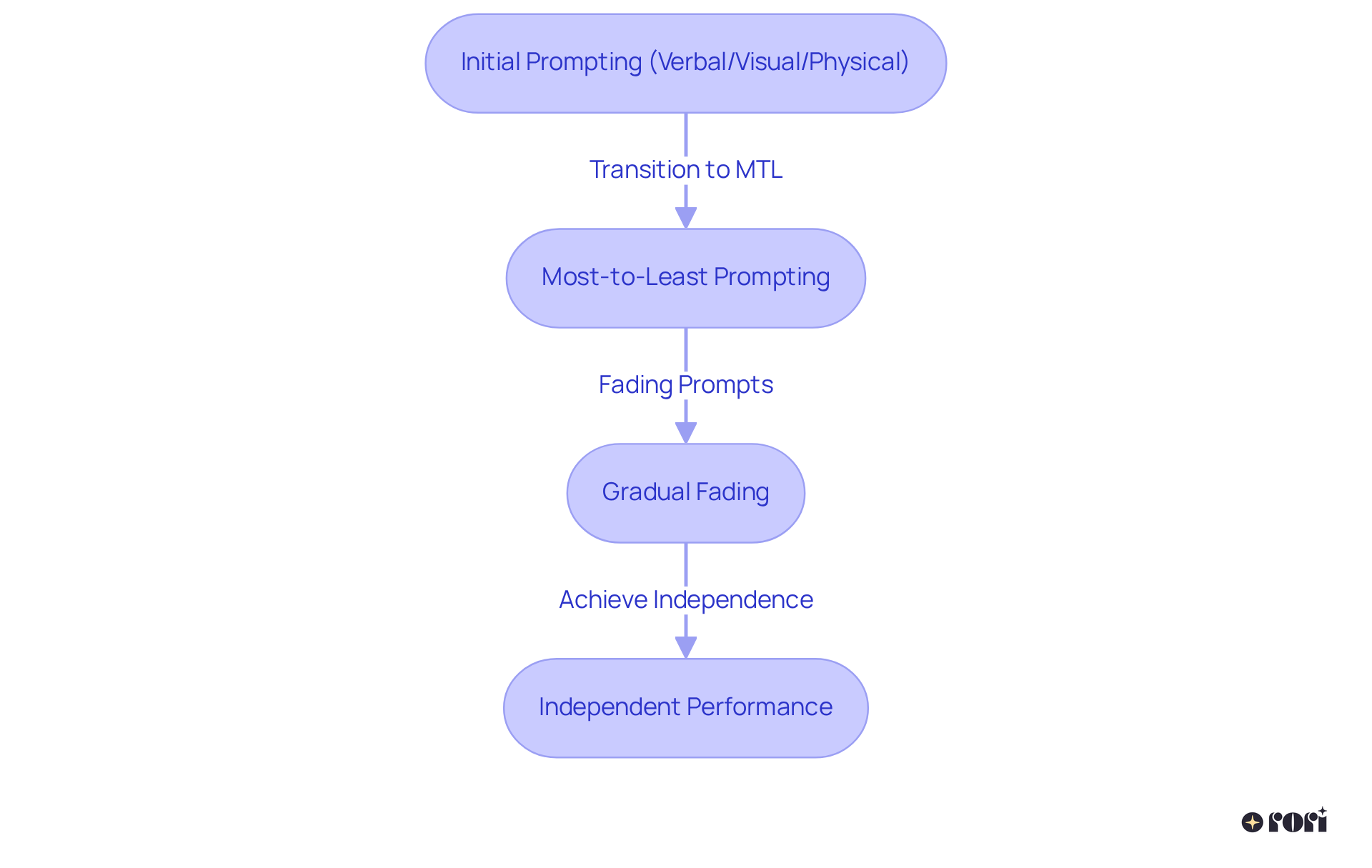
Training in social skills is so important for teaching our kids how to interact positively with both peers and adults. As parents, you play a vital role in this journey by creating opportunities for social interactions—think playdates or group activities—and by modeling the right social behaviors. Techniques like role-playing, social narratives, and even video demonstrations can be super helpful in teaching specific skills such as sharing, taking turns, and starting conversations.
Research shows that children who participate in structured social training, including group therapy led by qualified therapists, make impressive strides in their ability to connect with others. This leads to better relationships and an overall improved quality of life. For instance, role-playing scenarios allow young ones to practice real-life interactions in a safe environment, boosting their confidence and skills in social situations. One therapist noted that fostering positive interactions through social skills training is key to young people's emotional and social development.
Additionally, equipping caregivers with ABA intervention strategies enhances their ability to support their children's behavioral goals. This results in informed decision-making and better behavioral outcomes. By actively engaging in these practices, parents can help their children build meaningful connections and navigate social settings more effectively. This approach is especially beneficial for kids with Autism Spectrum Disorders, ADHD, Social Communication Disorders, and Anxiety Disorders. Let’s explore this together and empower our children to thrive socially!
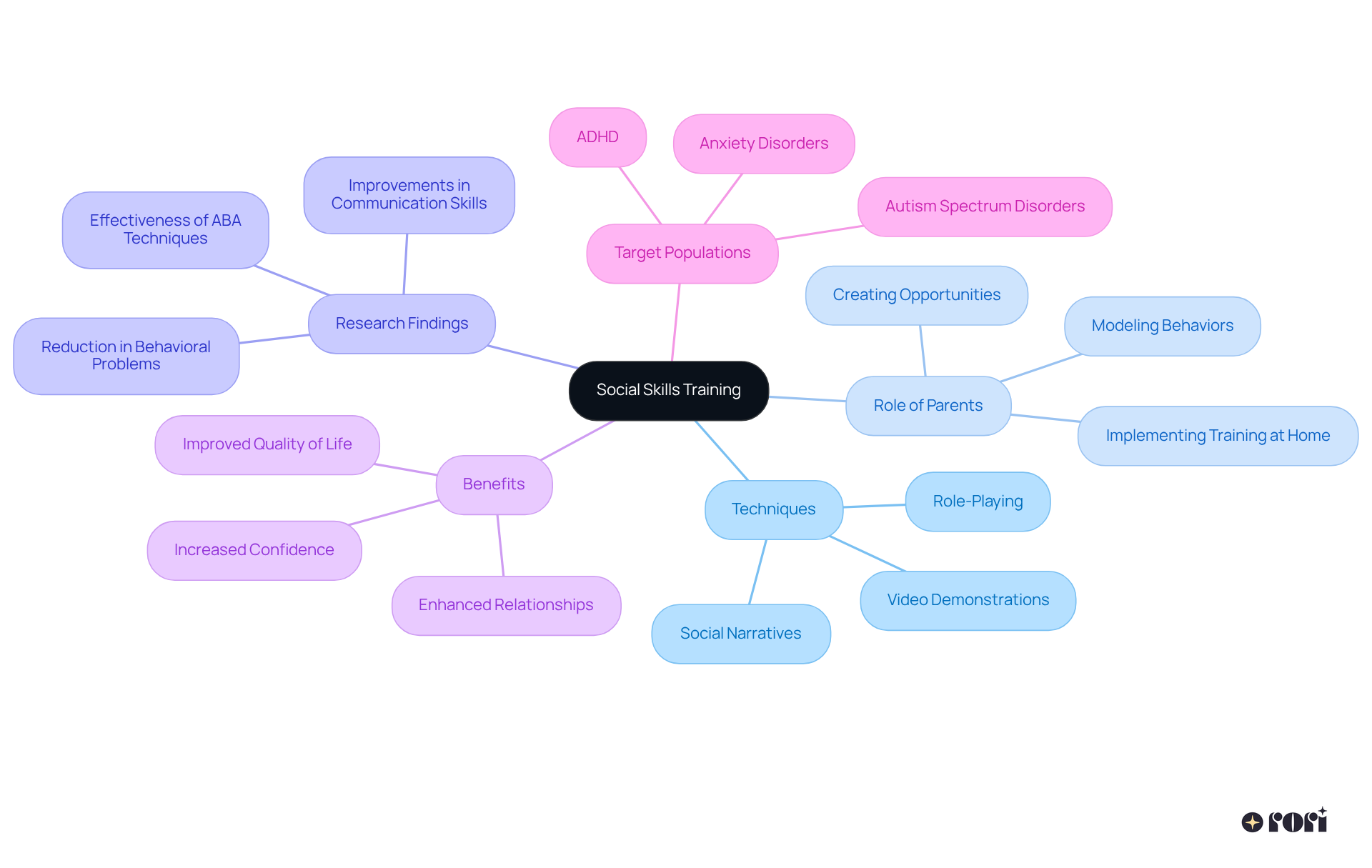
Gathering data is such an important part of effective ABA therapy! It allows parents to keep a close eye on their child's progress. A certified analyst crafts personalized plans filled with measurable goals and research-backed strategies, incorporating ABA intervention strategies to ensure that each intervention is tailored to meet a child's unique needs.
Parents can use a variety of tools—like checklists, charts, and even advanced digital platforms such as ArtemisABA and Catalyst—to track specific behaviors, skills, and responses to interventions. Regularly reviewing this data helps parents and clinicians work together, making it easier to assess how well strategies are working and to adjust treatment plans as needed.
This active involvement not only deepens the understanding of a child's development but also empowers caregivers with ABA principles. It’s all about helping you make informed decisions in your child’s care! Plus, innovative tools that provide real-time data entry and automated analysis can really lighten the load, reducing the chance of memory slips or transcription errors.
As behavior analysts often emphasize, consistent and accurate data collection is vital. It supports ongoing evaluation and modification of treatment plans, leading to meaningful improvements in ABA intervention strategies for autism. Ultimately, this means better outcomes for children and their families. So, let’s explore this journey together and see how we can make a difference!
![]()
Implementing effective ABA intervention strategies is so important for parents looking to support their children with autism. By taking a personalized approach, these strategies not only tackle specific behavioral challenges but also celebrate the unique strengths and interests of each child. This tailored methodology helps build meaningful connections between parents, clinicians, and young individuals, leading to wonderful behavior changes and developmental progress.
In this article, we’ve highlighted several key strategies, like:
Each of these methods plays a crucial role in enhancing communication, promoting independence, and helping kids acquire new skills. By understanding and using these techniques, parents can create a nurturing environment that truly encourages their children's growth and development.
Ultimately, supporting children with autism through ABA therapy is a collaborative effort. It requires dedication, adaptability, and ongoing engagement. Embracing these essential strategies not only empowers parents but also opens up pathways for their children to thrive socially and emotionally. The impact of timely and personalized interventions is huge; they are the key to unlocking a brighter future for young individuals facing behavioral challenges. Let’s explore this journey together, and remember, we’re here to help you every step of the way!
What is the approach taken by Rori Care for ABA therapy?
Rori Care uses a customized approach to ABA therapy, tailoring intervention strategies to address the unique behavioral challenges of each young person while celebrating their strengths and interests.
How does personalized support in ABA therapy benefit children and parents?
Personalized support helps parents and clinicians connect meaningfully with the child, leading to significant behavior changes and impressive developmental outcomes.
What do behavior analysts at Rori Care do?
Behavior analysts at Rori Care craft personalized behavior plans with measurable objectives and research-backed ABA intervention strategies, continuously assessing and fine-tuning the interventions to enhance results.
How effective is tailored ABA therapy?
Research indicates that individuals receiving tailored ABA therapy experience remarkable improvements in communication and adaptive functioning, with a success rate of over 89% in enhancing various developmental aspects.
What is the importance of timely intervention for individuals with Autism Spectrum Disorder (ASD)?
Timely intervention is crucial for individuals with ASD, typically starting before age five, as ABA intervention strategies play a vital role in providing early support.
What is positive reinforcement in the context of ABA therapy?
Positive reinforcement involves offering rewards after desired actions to encourage those actions to be repeated, using incentives like verbal praise, tokens, or special privileges.
How can parents effectively implement positive reinforcement?
Parents can effectively implement positive reinforcement by promptly acknowledging positive behaviors, using various rewards that motivate their children, and ensuring the reinforcement is immediate and consistent.
What is Discrete Trial Training (DTT)?
Discrete Trial Training (DTT) is a structured learning method that breaks down skills into smaller, manageable pieces, involving clear instructions, participant responses, and prompt feedback for effective learning.
How can parents use DTT at home?
Parents can use DTT at home by setting specific, measurable goals, providing clear prompts and consistent feedback, and creating a structured learning environment that minimizes distractions.
What are the benefits of using DTT for children with autism?
DTT has shown impressive results in improving learning, communication, and social skills for young individuals with autism, leading to greater independence and the ability to generalize learned behaviors across different settings.